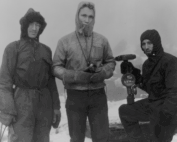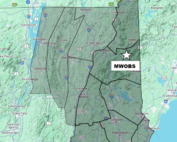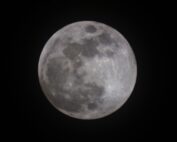Autumn 2022 Weather Was Warm, Wet, and Less Snowy
The fall of 2022 on Mount Washington will go down in the record books as a warm, wet, and less snowy season compared to average.
September started the season off on a slightly cooler note, with an average temperature of 42.8 degrees. This temperature corresponded with an anomaly of 0.3 degrees below the 1991-2010 baseline.
A tendency for ridging over the eastern United States during the month of October created the ideal conditions for anomalous warmth. In fact, at +6.4 degrees, October 2022 was the fifth warmest October in our 90-year record.
A record warm first half of November propelled the temperature anomalies for the month to +3.1 degrees above normal. Numerous daily high temperature records were matched on the 5th, 11th, and the 12th. A handful of new daily record high temperatures were observed on the 5th, 6th, and 12th.

The first true cold blast of the season covered the summit sign in feathery rime ice on Sept. 15.
Wind data showed a mixed bag of below and above average monthly wind speeds. September saw nearly average wind speeds, while October had a 9 mph lower-than-average wind speed (27 mph compared to 36 mph). November was the windiest month of the fall with an average wind speed that was nearly 7mph above average. In fact, with an average wind speed of 46.2 mph, November 2022 was the 10th windiest November on record.
Despite making landfall in Nova Scotia, the gradient between hurricane Fiona and an area of high pressure to the west brought the higher summits a maximum wind gust of 116mph on Sept. 23. This also happened to be the eighth highest September wind gust in our dataset as well as the season’s strongest gust.

There were several impressive precipitation events of note during the fall on Mount Washington. With 3.79 more inches of precipitation than normal, the month of September was the wettest month of the fall. Precipitation totaled 11.45 inches for the month, with the highest daily precipitation totals being measured on the 19th and 20th. This deluge resulted from a parade of storms that rode along a stalled frontal boundary.
On, average October is the wettest month for the summit as large-scale, mid-latitude cyclones begin to develop and signal the start of the cold season. This year saw a drier-than-normal October, with a 0.66” rainfall deficit. The largest 24-hour rainfall during the month occurred between the 13th and 14th when a slow moving cold front transported copious amounts of rain and embedded thunderstorms that tallied up to 5.74 inches!

Flooding associated with the Oct. 13-14 storm.
Finally, November was an anomalously wet month on top of Mount Washington. The summit saw 9.57 inches of precipitation over the month, which was 1.48 inches above average. The greatest daily total occurred on the 11th and 12th when the remnants of Hurricane Nicole merged with an upper level low and cold front and tracked towards the Northeast. This system ended up delivering 2.75 inches of rainfall and was followed by a sharp drop in temperatures.
The fall typically signals the return to substantial snowfall on the higher summits, and this fall certainly took its time doing so! September had average snowfall with 1.1 inches falling when Hurricane Fiona spread showers into an incoming (and very cold) upper level low.
The real oddball of the fall 2022 snow season was October. While our records show that Octobers typically get our true snow season started with an average of 19 inches of snow, 2022 had other ideas. With just 2.1 inches for the entire month, this was the fourth least snowy October on record! It took a strong cold front and upper level low to bring accumulating snow to the summit between the 8th and 10th of the month.
As a new observer, I witnessed the warmth and rain of early November with dismay. I was simply not aware of how quickly the tides can turn up here on the summit. As if someone flipped a switch, the second half of November featured numerous snow events. When all was accounted for, November ended up with 23.9 inches of snow. While this was definitely a decidedly wintry turn, it was still well below average (35.6 inches).
With this being my first fall up here, I can definitely say that despite the record warmth, this fall was unlike any fall I have ever experienced. My excitement for winter only builds as I write the blog with snow and hurricane force wind gusts just outside the window.
I would like to thank my fellow observer Ryan Knapp for the time he took to compile some of the wind, temperature, and snowfall statistics mentioned in this blog. If you are interested in keeping track of climate records on Mt. Washington, you can access our monthly F-6 data summaries anytime.

Observers celebrate the arrival of winter by writing “Hi” on the observation deck during one of the first accumulating snow events of November.
Francis Tarasiewicz, Weather Observer & Education Specialist
A Look at The Big Wind and Measuring Extreme Winds At Mount Washington
A Look at The Big Wind and Measuring Extreme Winds at Mount Washington By Alexis George Ninety-one years ago on April 12th, Mount Washington Observatory recorded a world-record wind speed of 231 mph. While
MWOBS Weather Forecasts Expand Beyond the Higher Summits
MWOBS Weather Forecasts Expand Beyond the Higher Summits By Alex Branton One of the most utilized products provided by Mount Washington Observatory is the Higher Summits Forecast. This 48-hour forecast is written by MWOBS
One Down, One To Go
One Down, One to Go By Ryan Knapp On my calendar for March 2025, I had two reminders of events to look forward to in the sky. The first occurred this past week with




